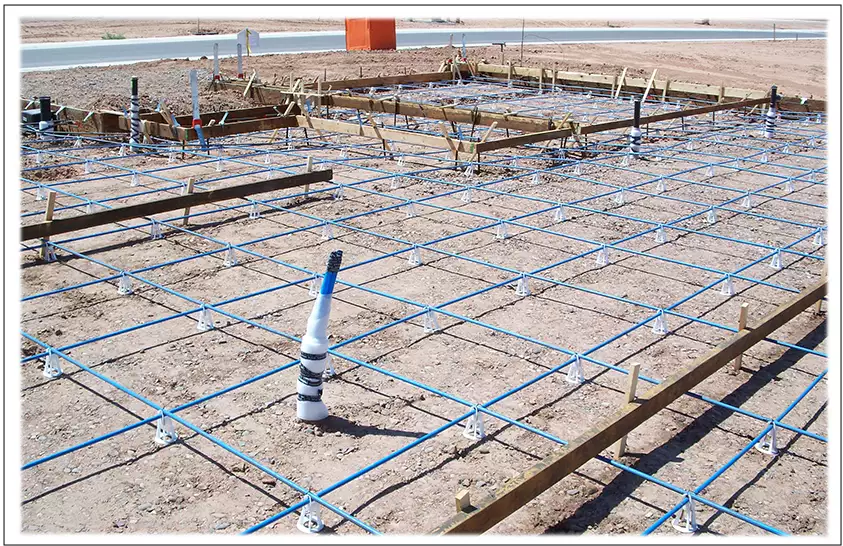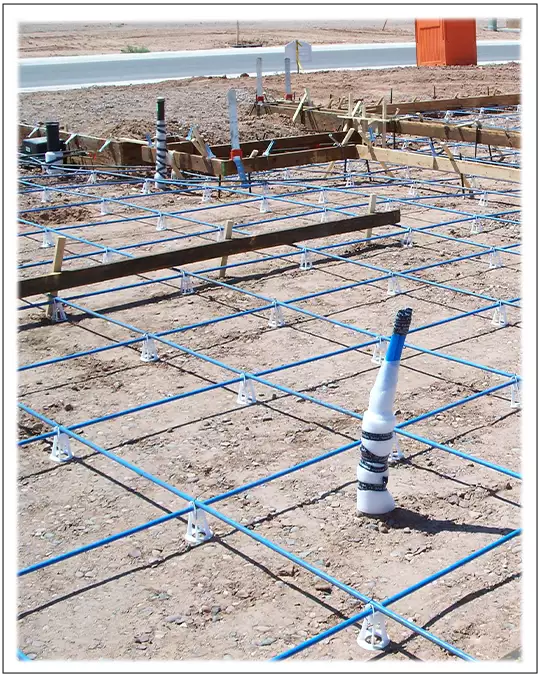

The Good & Bad of PT Slabs
Homes built on PT Slab Floors are far less likely to have Settlement Cracks caused by Expansive Soil or the Ground under the Concrete not being properly Prepared and Compacted.
PT Slab Floors Can Not Be Altered by Cutting or Drilling to Relocate or Add Electrical or Plumbing. When Hiring a Contractor be sure They know you have a PT Slab.
Constant moisture next to the Slab could get to the Cable Ends, start corrosion that can push away the Grout covering the Cable Ends that will weaken the Cable Tension.
Expansive Soil
Expansive Soil is described as being High in Clay Content. Clay Soils are prone to large Area Swelling from Moisture, then Contraction or Shrinking when Drying, causing Uneven Movement.
The Soil in the Phoenix Area and many other US States have High in Clay Content.
Do You have a PT Slab
If your Home has a PT Slab Foundation you will see a Stamping on the Garage Floor stating it is a Post Tension Slab Do Not Cut, Drill or Bore the Concrete. In Older Homes there should be a Notice next to the Door entering from the Garage.
If you are Purchasing a New or Pre-Owned Home ask your Representative if the Home is Built on a PT Slab, You should know.
Purpose of PT Slab
The uneven Movement of Expansive Soil Can and Does Cause Foundation and Floor Failure.
Concrete is Strong by Compression but weak in Tension. Weak by Tension means under certain conditions it can Break like Chalk. Post Tensioning is a System that uses Steel Cables in the Concrete as Reinforcement.
When the Cables have been Stressed, the force is Transferred to the Concrete increasing the Compression and Tension of the Entire Slab.
Post Tensioning Allows for Thinner, Wider and Stronger Concrete Foundation Floors.
The Cables
The Cables are about 1/2" Diameter and over 50 foot long. The Cables are Housed in a Plastic Sleeve that prevents them from bonding with the Concrete. After Curing and the Concrete has gained a Strength of 2000 pounds per square inch (psi) the Cables are Stressed.
Each Cable is Pulled by Hydraulics to 33,000 Pounds Load, Stretching each Cable about 4" in length. The Cables are automatically Clamped, the excess cut off, the Clamps and Cable Ends are then Sealed off with Grout.
Cable Failure
Cable Failure is Possible but Very Rare. If, in the unlikely event a Cable Failed it could be as uneventful as a pop or as Catastrophic as Exploding Concrete outside the Home.
Cable Failure can be caused by Poor Water Management around Landscaping or Leaking Irrigation too close to the Slab.
Collecting Rain Water Run Off can get under the PT Slab or near the Grouted Cable End. Some suggest extending the AC Condensation Drip line away from the Foundation.
Cable Failures can also be caused by a Poor Remodeling Contractor hitting or cutting a Cable if they are not aware of the Cables and their Tension.
Are PT Slabs New
PT Slab Foundations are Not new, Research shows the first use of Post Tension in the US was in the 1950's.
In the Phoenix and other areas in the US, as we move out from the Cities to available land to build on. Builders are seeing more Clay or expansive soil making PT Slabs Foundations more popular.
New Home Construction has seen a sharp increase in the use of PT Slab Foundations in the last 25 years throughout the US.
Are Post Tension Foundations Worry Free
Most feel the Post Tension Slab Foundation is Worry Free. Occasional Inspections by the Homeowner could see Potential Problems caused by Moisture.
Don't Plant Scrubs or Plants close to the foundation for 2 Reasons. Constant Moisture near the Cable End Section of the Foundation and an Invitation for Termites.
If you are Selling or Buying a Home have a Professional Inspector that is Familiar with the Post Tensioning Concrete System inspect Carefully.
Remodeling a Home with a PT Floor
When Remodeling a Home that has been Constructed on a Post Tensioning Slab Foundation be Aware of the Problems that Could be caused by a Uninformed Home Owner or Contractor.
We are very Supportive of the DIY Homeowner. Sometimes you Contract with others to Help with your Project. You and Your Contractor must be Aware of the Potential Problems with the Post Tension Slabs.
Follow the Rule Do Not Cut, Drill or Bore the Concrete.
Interesting Facts
Is it Concrete or Cement? Portland Cement along with Water and other ingredients make a Fluid Cement Mixture. The Cement then Cures or Hardens to make Concrete.
Concrete by itself is like chalk it breaks easily. Add Steel Reinforcement (Cables) to Concrete and It very Strong no longer like chalk.
Like this Article, you can give us a Thumbs just click on the Icon. It's anonymous and we will Thank You.

“An ounce of prevention is worth a pound of cure”
Ben Franklin
© Copyright 2023 YPRemodel.com. All rights Reserved. This material may not be Published, Broadcast, Rewritten or Redistributed without written Permission.
